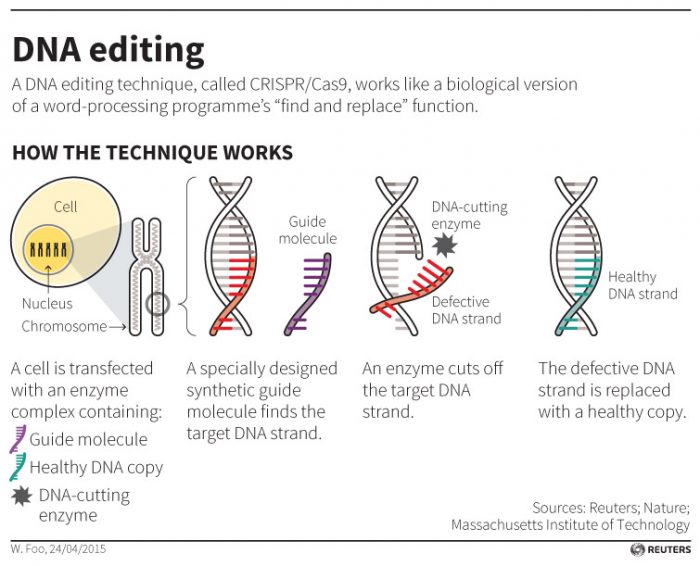Swedish Scientist Edits Genes of Healthy Embryos for First Time

In what is believed to be a first, a Swedish scientist has attempted to edit DNA in healthy human embryos. [1]
Developmental biologist Fredrik Lanner is the first known researcher to conduct the experiment, which has long been considered taboo due to safety and ethical concerns.
Why Edit Embryonic DNA?
Lanner is editing the embryos’ genes in an attempt to learn more about how they regulate early embryonic development, as well as to develop new ways to treat infertility and prevent miscarriages. Additionally, Lanner hopes his efforts will help scientists learn more about embryonic stem cells so that they can someday use the cells to treat a wide number of diseases.
The researcher said he is initially planning to study the genetically engineered (GE) embryos only for the first seven days of their growth, and has no plans to let them develop past 14 days. Said Lanner:
“Having children is one of the major drives for a lot of people. For people who do struggle with this, it can tend to become an extremely important part of your life.”
He went on:
“If we can understand how these early cells are regulated in the actual embryo, this knowledge will help us in the future to treat patients with diabetes, or Parkinson, or different types of blindness and other diseases. That’s another exciting area of research.”
The Process

NPR visited Lanier’s labs at the Karolinska Institute in Stockholm to see just how the embryos are edited. [1]
During the visit, Lanner and a graduate student thawed five embryos donated by couples who had gone through in-vitro fertilization at the Karolinska University Hospital in an effort to have children.
All but one of the embryos survived the freezing and thawing process. Each of the remaining two-day-old embryos were placed by the researchers into a dish on a special microscope.
Lanner joked:
“You need to be stable on your fingers and hands while doing this. You don’t want to be dropping the embryos while taking them out.”
Then the graduate student injected one of each embryo’s four cells with the genetic engineering tool, CRISPR-Cas9, while holding the embryo in place using a thin glass rod.
CRISPR-Cas9 is composed of two molecules that can pinpoint individual genes and make very specific changes in the DNA. It’s a much quicker and much more precise way of modifying DNA than other used methods.
So far, Lanner has edited at least 12 embryos, but he’s still studying his results and tweaking his techniques. Although he’s unsure of how the process is working so far, he’s fairly certain he’ll be able to modify individual genes in the embryos to determine their function.
Science Mired in Controversy
Gene-editing has potential for amazing, life-saving medical breakthroughs. As I wrote about recently, stem cells taken from umbilical cord blood show great promise in treating leukemia. It can be hard to find a match for bone marrow or red blood cells, but nearly everyone has an umbilical-cord stem cell match.
Once the process is perfected, editing human embryos could allow scientists to delete the genes associated with all sorts of diseases and health problems, including the much-dreaded Alzheimer’s disease.
Lanner explained:
“If we can understand how these early cells are regulated in the actual embryo, this knowledge will help us in the future to treat patients with diabetes, or Parkinson, or different types of blindness and other diseases. That’s another exciting area of research.” [2]
But many worry that gene-editing could result in “designer babies” – children created with only the best aspects of each parent. Scientists would be able to delete undesirable strands of DNA, resulting in babies being born with superior intelligence, artistic skills, or looks.
(When I say “each parent,” I don’t necessarily mean just two. Last February, a panel of U.S. scientists and ethicists approved a fertility treatment requiring three genetic parents.)
Another fear is that the practice could result in the introduction of new diseases into the human gene pool that could be passed down to future generations.
Then there is the real possibility that gene-editing could be used as a weapon of mass destruction (WMD). Daniel Gerstein, senior policy analyst at RAND and former undersecretary at the Dept. of Homeland Security, said last winter:
“Biotechnology, more than any other domain, has great potential for human good, but also has the possibility to be misused. We are worried about people developing some sort of pathogen with robust capabilities, but we are also concerned about the chance of misutilization. We could have an accident occur with gene editing that is catastrophic, since the genome is the very essence of life.”
Scientists and activists have been so concerned about the potential negative implications of gene-editing that many of them have called for a ban on the practice, saying “there is no medical justification for modifying human embryos or gametes in an effort to alter the genes of a future child.”
Lanner says that creating “designer babies” isn’t even on his radar.
“It’s not a technology that should be taken lightly. So I really, of course, stand against any sort of thoughts that one should use this to design designer babies or enhance for aesthetic purposes.”
Sources:
[1] NPR
[2] CBS News
